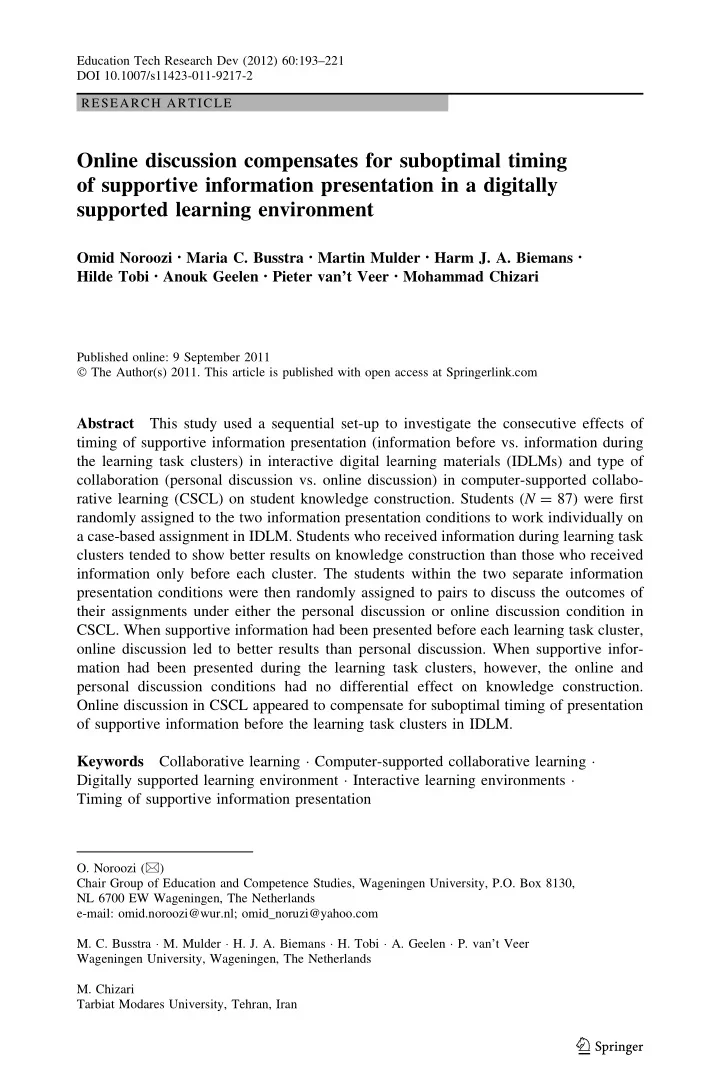

Education Tech Research Dev (2012) 60:193–221 DOI 10.1007/s11423-011-9217-2 RESEARCH ARTICLE Online discussion compensates for suboptimal timing of supportive information presentation in a digitally supported learning environment Omid Noroozi • Maria C. Busstra • Martin Mulder • Harm J. A. Biemans • Hilde Tobi • Anouk Geelen • Pieter van’t Veer • Mohammad Chizari Published online: 9 September 2011 � The Author(s) 2011. This article is published with open access at Springerlink.com Abstract This study used a sequential set-up to investigate the consecutive effects of timing of supportive information presentation (information before vs. information during the learning task clusters) in interactive digital learning materials (IDLMs) and type of collaboration (personal discussion vs. online discussion) in computer-supported collabo- rative learning (CSCL) on student knowledge construction. Students ( N = 87) were first randomly assigned to the two information presentation conditions to work individually on a case-based assignment in IDLM. Students who received information during learning task clusters tended to show better results on knowledge construction than those who received information only before each cluster. The students within the two separate information presentation conditions were then randomly assigned to pairs to discuss the outcomes of their assignments under either the personal discussion or online discussion condition in CSCL. When supportive information had been presented before each learning task cluster, online discussion led to better results than personal discussion. When supportive infor- mation had been presented during the learning task clusters, however, the online and personal discussion conditions had no differential effect on knowledge construction. Online discussion in CSCL appeared to compensate for suboptimal timing of presentation of supportive information before the learning task clusters in IDLM. Keywords Collaborative learning � Computer-supported collaborative learning � Digitally supported learning environment � Interactive learning environments � Timing of supportive information presentation O. Noroozi ( & ) Chair Group of Education and Competence Studies, Wageningen University, P.O. Box 8130, NL 6700 EW Wageningen, The Netherlands e-mail: omid.noroozi@wur.nl; omid_noruzi@yahoo.com M. C. Busstra � M. Mulder � H. J. A. Biemans � H. Tobi � A. Geelen � P. van’t Veer Wageningen University, Wageningen, The Netherlands M. Chizari Tarbiat Modares University, Tehran, Iran 123
194 O. Noroozi et al. The separate effects of interactive digital learning materials (IDLMs) and computer- supported collaborative learning (CSCL) on student learning are well researched, yet no empirical study has addressed the consecutive effects of these two learning arrangements on knowledge construction. Platforms for digitally supported learning environments such as IDLM and CSCL assist learners in the acquisition and construction of knowledge (e.g. Jonassen 2004; Verhoeven and Graesser 2008). Well-designed IDLM environments pro- vide learners with various modes of information presentation, such as interactive texts, exercises, graphs, diagrams, animations, pictures, etc., that can support learners’ knowl- edge construction (e.g. Busstra et al. 2008; Jonassen 2004; Verhoeven and Graesser 2008; Verhoeven et al. 2009). The effect of timing of information presentation in IDLM on student learning performance has been a subject of interest to many researchers across a range of disciplines (e.g. Jonassen 1999; Kester 2003; Van Merrie ¨nboer et al. 2003). This is important since optimal timing of information presentation should take into account the load a task imposes on the learner’s cognitive system (e.g. Kester et al. 2001; Van Merrie ¨nboer and Sweller 2005). The literature points out that various types of information such as supportive, procedural, declarative, prerequisite, etc. require different timing of presentation (information before ‘‘IB’’ or information during ‘‘ID’’ the learning task) in IDLM. In spite of a general consensus among researchers on the preferable timing of presenting most types of information (e.g. procedural, declarative, prerequisite, etc.), mixed findings have been reported regarding the effects of timing of ‘‘supportive’’ infor- mation presentation on learning performance in IDLM (e.g. Kester et al. 2004a, 2006a). This is a striking gap, since optimal timing of presentation of supportive information could promote meaningful learning by giving the learners maximal opportunity to reason about and elaborate on the learning materials and new information and help them connect these to their existing, relevant cognitive structures (Kester et al. 2001, 2006a). Without such supportive information, presented at the preferable time, it would be very difficult, if not impossible, to direct learners’ attention to and help them identify relations between rele- vant aspects of the tasks to foster meaningful learning. This study was therefore intended to contribute to the existing literature on learning in IDLM by investigating the effect of timing of supportive information presentation on student performance. In educational practice, a fruitful approach can be to compensate for the possible limitations of a particular intervention by introducing a complementary intervention. In this study, immediately after the first intervention (presentation of supportive information in IDLM), a second intervention (collaboration in CSCL with graphical knowledge maps) was introduced to examine the consecutive effects of these two interventions on students’ knowledge construction. Collaborative and networked learning arrangements e.g. CSCL with graphical knowledge maps provide students with a shared learning environment in which to discuss their ideas, concepts, views and questions with their peers. This allows them to co-construct new and re-construct existing knowledge based on what they have learned while working in IDLM. Within CSCL, graphical knowledge maps have evolved to improve knowledge construction and deep learning (e.g. Janssen et al. 2010; Van Amelsvoort et al. 2007). Despite extensive research on CSCL, no empirical study has compared the effects on knowledge construction of two types of collaboration (personal discussion ‘‘PD’’ in front of a shared computer and online discussion ‘‘OD’’ using a textual chat tool) in CSCL with graphical knowledge maps. Furthermore, no empirical study has addressed the consecutive effects of IDLM and CSCL using graphical knowledge maps on students’ knowledge construction. This study therefore used a sequential set-up (see Campbell and Stanley 1963) to investigate the effect of type of collaboration (PD vs. OD) in CSCL with graphical 123
Recommend
More recommend